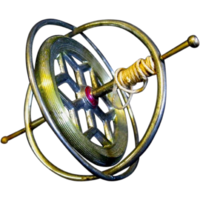It is all about the "rotational moment of inertia", the overall mass of the wheel tyre are also relevant, but the bit that really matters is where the mass is relevant to the centre of the hub.
The ice scatter best demonstrates this when the are spinning on a vertical axis and they pull their arms in, their rpm increases dramatically; then push their arms out and they slow down. Their energy is constant(ish), so when the weight is moved outwards the revolutions slow, and it reverses back as the arms are moved in.
A gyroscope has most of its mass in its outer

(opps a bit big).
So the energy stored in a rotating wheels is mostly about where that weight is. The energy stored = how hard it is to spin the wheel up=how hard it is to brake the spinning wheel=how hard it is to disturb the spinning wheel (steering)
As the distance from the centre doubles, then the energy or inertia quadruples, a squared relationship.
The gyroscope effect is also responsible for keeping you moving in a straight line, so it is harder on steering and tyres to change direction with a high moment of inertia. (ask any motorbike racer)
Back to the debate, for a constant rolling radius, the lowest moment of inertia will be easier to accelerate/brake/turn; and that is a wheel tyre with the lowest weight particularly around the tyre/rim area and not so much around around the centre part.
When I ran AllTerrain tyres on my T5 which are heavy old lumps because of tread and puncture/cut resistance etc, you could certainly tell the driving characteristics had altered (oh and they were 7.5% bigger).
Increasing your tyres width also has a big impact on this; the tyre is relatively heavy and is further from the centre of the hub than the wheel; but sometimes with lower profile tyres you have to go wider to get the load ratings
I guess the question is how relevant is all this compare to the 3tonne gross weight of the vehicle you are trying to accelerate/brake/turn; with its brick like aerodynamics; I could try and working it out, but I would guess most of us a bored shitless by now

I think that a light weight larger diameter wheel with a light weight tyre (low profile - not much side wall), and reasonably narrow in section width would be fine in terms of load on the transmission/suspension; if your rolling radius increases that will alter the gearing though. What VW(UK) or a dealer think is a totally different matter

If you look at similar size vehicles like an SUV's, the manufacturer will offer from 17"/18" upto 22" size wheels on the same model say a Rangerover/Volvo XC etc, so surely it can't make that much difference. VW probably resist the larger wheels, because tyres become such a problem re load rating etc, and the fact that van wheels are not standard sizing compared to most SUV's which share similar tyre sizes.
I wonder though when the T7 appears if it will keep the same size of wheel/tyres that have been around for so long. Particularly with all electric models, which seem to favour larger diameter wheels, and often skinnier

